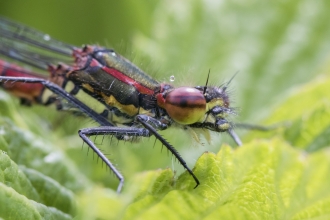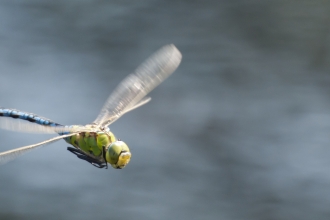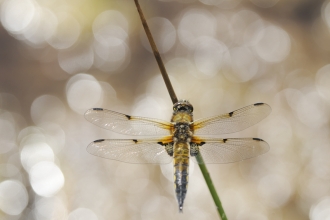
Ross Hoddinott/2020VISION
Damselflies and dragonflies
What are they?
No summer outing would be complete without hearing the tell-tale sound of a patrolling dragonfly as it hunts over a nearby pond. Their aerial manoeuvres rival the fastest military aircraft as they duck and turn in pursuit of prey, or narrowly avoid the clutches of hungry hobbies. These adaptable insects lord over wetlands, moorland and even woodland glades, feeding on flies, midges and even each other. If you thought butterflies were the only insects worth a second glance, these multi-coloured, iridescent predators demand appreciation too.
Where can you see them?
Summerseat Nature Reserve
Woodland with a stand of common reed, the two ponds on the site provide a fascinating habitat for dragonflies and damselflies such as the broad-bodied chaser, the large red damsel, the southern hawker, the common hawker and the emerald damselfly. Amphibians are also abundant, with both smooth and palmate newts present.
Brockholes Nature Reserve
The reserve, along the banks of the River Ribble, comes alive with colour during the summer months. The many wildflowers attract many different types of dragonfly and butterflies, such as the gatekeeper and common blue. The edge of the Nook Pool has been planted with reed to create places for small fish and aquatic invertebrates like dragonfly larvae to hide and grow, away from predator fish. The shelter provided by the vegetation provides an ideal hunting ground for lots of species of dragonfly including the impressive brown hawker and emperor dragonfly.
Highfield Moss
There are a number of pools on site, one of which is rumoured to be bottomless and in the past was used by locals to learn how to swim. These days the pools are home to a number of species of dragonfly, including the black darter, common hawker, four-spotted chaser and emerald damselfly.
Freeman's Pools
A range of wetland and grassland invertebrates are supported here, including breeding dragonflies such as black-tailed skimmer, emperor and four-spotted chaser.
Other areas of note
Cadishead Moss and Little Woolden Moss
Mere Sands Wood - This site is nationally important for wildfowl and dragonflies.
Pleasington Old Hall Wood - Successful management has encouraged up to seven species of dragonfly.
More information
Nearly all the dragonfly’s head is eye, so they have incredible vision that encompasses almost every angle except right behind them.






